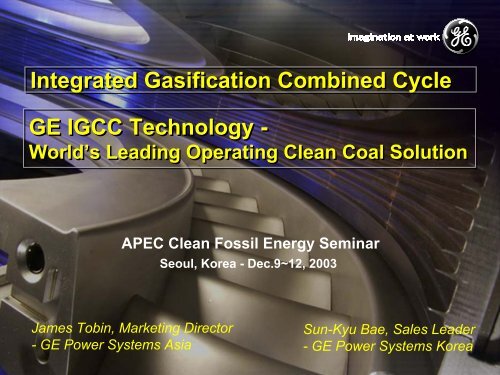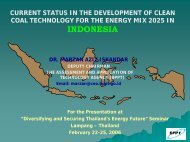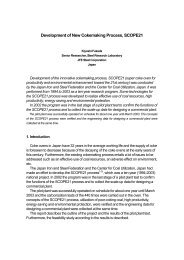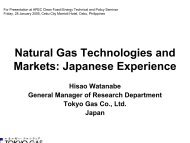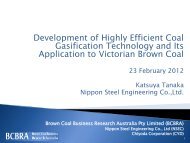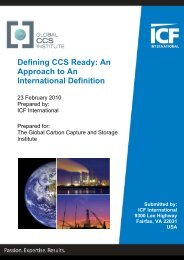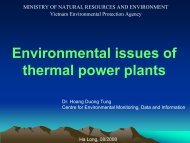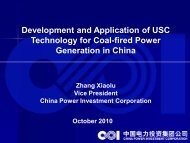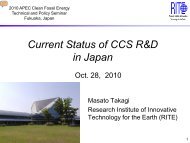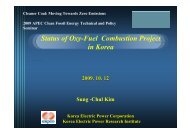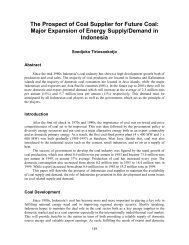Integrated Gasification Combined Cycle GE IGCC ... - apec egcfe
Integrated Gasification Combined Cycle GE IGCC ... - apec egcfe
Integrated Gasification Combined Cycle GE IGCC ... - apec egcfe
You also want an ePaper? Increase the reach of your titles
YUMPU automatically turns print PDFs into web optimized ePapers that Google loves.
<strong>Integrated</strong> <strong>Gasification</strong> <strong>Combined</strong> <strong>Cycle</strong><br />
<strong>GE</strong> <strong>IGCC</strong> Technology -<br />
World’s Leading Operating Clean Coal Solution<br />
APEC Clean Fossil Energy Seminar<br />
James Tobin, Marketing Director<br />
- <strong>GE</strong> Power Systems Asia<br />
Seoul, Korea - Dec.9~12, 2003<br />
Sun-Kyu Bae, Sales Leader<br />
- <strong>GE</strong> Power Systems Korea
Presentation Outline<br />
Discussion Topics<br />
• <strong>IGCC</strong> Process<br />
• <strong>IGCC</strong> Players<br />
• Experience<br />
• Competitive Comparison<br />
• Economics<br />
• Fuel Flexibility<br />
• Environmental<br />
• Availability<br />
• Summary
What is <strong>Gasification</strong>?<br />
<strong>Gasification</strong> is…<br />
• Not combustion<br />
• A thermo-chemical process<br />
• High temperature (+2,200 o F),<br />
elevated pressure<br />
• Operates in a reducing (oxygenstarved)<br />
mode with steam<br />
• Complete conversion of<br />
feedstock, no toxics<br />
• Produces clean synthesis gas &<br />
useful byproducts<br />
Converts Solid Fuel to H 2 and CO
<strong>IGCC</strong> Subsystems<br />
Fuels<br />
� Bituminous Coal<br />
� Sub Bituminous Coal<br />
� Lignite<br />
� Orimulsion<br />
� Residual Oils<br />
� Refinery Bottoms<br />
� Petroleum Cole<br />
� Biomass<br />
� Wastes<br />
Slag<br />
<strong>Gasification</strong><br />
Gasifier HX<br />
Oxidant<br />
Supply<br />
System<br />
5 Technologies<br />
Oxidant Supply<br />
<strong>Gasification</strong><br />
Clean Up<br />
<strong>Combined</strong> <strong>Cycle</strong><br />
Integration<br />
<strong>Combined</strong><br />
<strong>Cycle</strong><br />
- Air or Oxygen<br />
-CO + H2<br />
-Sulfur<br />
- Syngas<br />
-Synergy<br />
Cleanup<br />
Syngas<br />
<strong>IGCC</strong> is a Collaborative Effort<br />
Clean<br />
Fuel<br />
Products<br />
Sulfur<br />
Slag<br />
Hydrogen<br />
Ammonia<br />
Methanol<br />
Chemicals<br />
Electricity<br />
GT 25689B
Key Technology Players<br />
Gasifiers & Clean-Up:<br />
- Texaco<br />
- Shell<br />
- Global / E-Gas<br />
- Lurgi<br />
- Noel<br />
Power Block (GT/ST):<br />
- General Electric<br />
- Siemens-Westinghouse<br />
-MHI<br />
-Alstom<br />
O&M:<br />
- Eastman (<strong>Gasification</strong> Island)<br />
Air Separation Units:<br />
- Air Products International<br />
- BOC Group<br />
-Praxair<br />
- Air Liquide<br />
EPC Contractors:<br />
- Bechtel<br />
- Krupp-Uhde<br />
- Fluor Daniel<br />
- Foster Wheeler<br />
- Snamprogetti
KEY <strong>GE</strong> Technological Milestones<br />
• Cool Water Demo Plant 1984<br />
First Large Scale <strong>IGCC</strong>. Demonstrated<br />
<strong>IGCC</strong> Technical Feasibility.<br />
• Polk Tampa Electric 1996<br />
Successful Nitrogen Injection for NOx Control. Demonstrated <strong>IGCC</strong><br />
Commercial Feasibility. .<br />
• Exxon Singapore 2000<br />
Widest Variety of Gas Turbine<br />
Fuels Demonstrating Multi-Fuel<br />
Flexibility<br />
58 Years of <strong>GE</strong> Commitment
<strong>IGCC</strong> Penetration<br />
Customer C.O. Date MW Application Gasifier<br />
SCE Cool Water - USA<br />
LGTI - USA<br />
Demkolec - Netherlands<br />
PSI/Global - USA<br />
Tampa Electric - USA<br />
Texaco El Dorado - USA<br />
SUV - Czech.<br />
Schwarze Pumpe - Germany<br />
Shell Pernis - Netherlands<br />
Puertollano - Spain<br />
Sierra Pacific - USA<br />
ISAB - Italy<br />
API - Italy<br />
MOTIVA - Delaware<br />
Sarlux/Enron - Italy<br />
EXXON - Singapore<br />
FIFE - Scotland<br />
EDF/ Total - Gonfreville<br />
JGC/MHI<br />
Nihon Sekiyu - Japan<br />
<strong>GE</strong> GTs<br />
1984<br />
1987<br />
1994<br />
1995<br />
1996<br />
1996<br />
1996<br />
1996<br />
1997<br />
1998<br />
1998<br />
1999<br />
2000<br />
2000<br />
2000<br />
2000<br />
2001<br />
2003<br />
2003<br />
2004<br />
120<br />
160<br />
250<br />
260<br />
260<br />
40<br />
350<br />
40<br />
120<br />
320<br />
100<br />
500<br />
250<br />
240<br />
550<br />
180<br />
120<br />
400<br />
341<br />
350<br />
4,951<br />
Power/Coal<br />
Cogen/Coal<br />
Power/Coal<br />
Repower/Coal<br />
Power/Coal<br />
Cogen/Pet Coke<br />
Cogen/Coal<br />
Power/Sludge<br />
Power/ H 2/Cogen/Oil<br />
Power/ Oil<br />
Power/Oil<br />
20 Global <strong>IGCC</strong> Plants<br />
Texaco - O 2<br />
Destec - O 2<br />
Shell - O 2<br />
Destec - O 2<br />
Texaco - O 2<br />
Texaco - O 2<br />
ZUV - O2 Power/Methanol/Lignite Noell - O2 Cogen/H2/Oil Shell - O2 Power/Coal/Pet Coke Prenflow - O2 Power/Coal<br />
KRW - Air<br />
Power/H2/Oil Texaco - O2 Power/H2/Oil Texaco - O2 Repower/Pet Coke Texaco - O2 Cogen/H2/Oil Texaco - O2 Cogen/H2/Oil Texaco - O2 BGL - O 2<br />
Texaco - O 2<br />
IHI – O2<br />
Texaco - O 2
<strong>GE</strong> Gas Turbine Syngas Experience<br />
September 2002<br />
Customer<br />
Cool Water<br />
PSI<br />
Tampa<br />
Texaco El Dorado<br />
Sierra Pacific<br />
SUV Vresova<br />
Schwarze Pumpe<br />
Shell Pernis<br />
ISE / ILVA<br />
Fife Energy<br />
Motiva Delaware<br />
Sarlux<br />
Piombino<br />
Exxon Singapore<br />
<strong>GE</strong> Syngas Hours of Operation<br />
Type MW<br />
Syngas<br />
Start<br />
Date Hours of Operation<br />
107E<br />
7FA<br />
107FA<br />
6B<br />
106FA<br />
209E<br />
6B<br />
2x6B<br />
3x109E<br />
6FA<br />
2x6FA<br />
3x109E<br />
109E<br />
2x6FA<br />
120<br />
262<br />
250<br />
40<br />
100<br />
350<br />
40<br />
80<br />
540<br />
80<br />
240<br />
550<br />
150<br />
180<br />
5/84<br />
11/95<br />
9/96<br />
9/96<br />
-<br />
12/96<br />
9/96<br />
11/97<br />
11/96<br />
-<br />
8/00<br />
10/00<br />
10/00<br />
3/01<br />
Syngas N.G. Dist.<br />
27,000<br />
24,500<br />
33,500<br />
30,660<br />
0<br />
90,040<br />
37,600<br />
58,250<br />
141,000<br />
0<br />
450<br />
33,100<br />
12,400<br />
9,700<br />
Totals 499,100<br />
-<br />
1,800<br />
-<br />
56,372<br />
48,438<br />
1,715<br />
-<br />
22,687<br />
4,732<br />
26,220<br />
-<br />
-<br />
2,930<br />
12,776<br />
1,000<br />
4,100<br />
7,101<br />
-<br />
-<br />
-<br />
3,800<br />
-<br />
-<br />
-<br />
5,290<br />
10,500<br />
-<br />
921<br />
<strong>IGCC</strong> Product Technology – Proven<br />
Through Operating Experience
<strong>IGCC</strong> Economics<br />
US $/KW<br />
3000<br />
2500<br />
2000<br />
1500<br />
1000<br />
500<br />
0<br />
<strong>IGCC</strong> Cost Learning Curve<br />
Coolwater<br />
Demo Config<br />
Coolwater<br />
Commercial<br />
Polk<br />
Demo Config<br />
Polk<br />
Commercial<br />
1980 1985 1990 1995 2000 2005<br />
YEAR OF OPERATION<br />
<strong>IGCC</strong> on Steep Learning Curve
<strong>IGCC</strong> Economics<br />
Economic Comparison of <strong>IGCC</strong> versus <strong>Combined</strong> <strong>Cycle</strong><br />
based on 20 year COE for large power plants<br />
<strong>IGCC</strong> Fuel Price [$/MMBTU]<br />
2.2<br />
2<br />
1.8<br />
1.6<br />
1.4<br />
1.2<br />
1<br />
0.8<br />
0.6<br />
0.4<br />
0.2<br />
Orimulsion<br />
Coal<br />
Residues<br />
Pet Coke<br />
<strong>Combined</strong> <strong>Cycle</strong><br />
Preferred<br />
0<br />
1.5 2 2.5 3 3.5 4 4.5 5 5.5<br />
<strong>Combined</strong> <strong>Cycle</strong> Fuel Price [$/MMBTU]<br />
<strong>IGCC</strong><br />
Preferred<br />
COE<br />
Parity<br />
COE<br />
Parity<br />
<strong>IGCC</strong> Competitive at $3.00 Fuel Spread
<strong>IGCC</strong> – Cost of Electricity<br />
C/kWh (20 Yr. Levelized)<br />
6<br />
5<br />
4<br />
3<br />
2<br />
1<br />
0<br />
F<br />
Gas<br />
F<br />
LNG<br />
<strong>Combined</strong><br />
<strong>Cycle</strong><br />
Lower<br />
Quality<br />
Fuel<br />
Option<br />
F F Ref.<br />
Coal Bottoms<br />
<strong>IGCC</strong><br />
Basis:<br />
1.5 $/Mbtu Coal<br />
1.0 $/Mbtu Bottoms<br />
2.5 $/Mbtu Gas<br />
4.0 $/Mbtu LNG<br />
Coal Ref.<br />
Bottoms<br />
Steam<br />
Fuel<br />
O&M<br />
Capital
NG vs. Solid Fuels<br />
Higher As-Fired<br />
Weight % As-Received<br />
Heating Heating<br />
Value Value Cost Carbon Ash Sulfur H2 CO2 Fuel<br />
BTU/lb BTU/scf $/MMBtu % % % % lb/MMBtu<br />
Natural Gas 21,514 911 $4.35 80.0% 0.0% 0.0% 20.0% 131<br />
Coal (Illinois #6) 11,666 277 $1.25 63.8% 9.7% 2.5% 4.5% 211<br />
PetCoke 14,026 268 $0.60 81.1% 0.6% 5.7% 4.3% 223<br />
A Current 500MW Coal Plant annually produces<br />
4,151,000 tons CO 2<br />
139,000 tons Ash<br />
306,000 tons Sludge<br />
5,901 tons SO 2<br />
2,950 tons NOx<br />
Why Coal Plants are Called the “Big Dirties”
<strong>IGCC</strong> Environmental Benefits<br />
SOA Combustion Plant<br />
Boiler SCR<br />
Baghouse<br />
95% SO 2<br />
Wet Wet<br />
Scrubber<br />
Results<br />
NOx: 0.10 lb/MMBtu<br />
SO 2 : 0.25 lb/MMBtu<br />
PM: 0.03 lb/MMBtu<br />
<strong>Integrated</strong> <strong>Gasification</strong> <strong>Combined</strong> <strong>Cycle</strong> on High Sulfur Coal Results<br />
NOx: 0.07 lb/MMBtu<br />
Syngas COS<br />
Gasifier Syngas COS MDEA<br />
Gas Gas SO2 : 0.10 lb/MMBtu<br />
Gasifier Scrubber Hydrolysis Hydrolysis Scrubber<br />
Turbine PM: 0.01 lb/MMBtu<br />
Scrubber<br />
Turbine<br />
NOxEmissions NOxEmissions - lb/MW<br />
6.0<br />
5.0<br />
4.0<br />
3.0<br />
2.0<br />
1.0<br />
5.5<br />
0.0 National<br />
Coal Average<br />
1.68<br />
0.29-0.72<br />
NSPS SOA Pulverized<br />
Coal SCR<br />
0.23-0.42<br />
<strong>IGCC</strong><br />
SO2 Emissions (lb/MMBtu)<br />
1.4<br />
1.2<br />
1.0<br />
0.8<br />
0.6<br />
0.4<br />
0.2<br />
0.0<br />
1.22<br />
National<br />
Average<br />
1998<br />
0.51<br />
Average<br />
WFGD PC<br />
1998<br />
0.1<br />
New PC<br />
PRB Coal<br />
WFGD/ SCR<br />
0.07<br />
<strong>IGCC</strong><br />
Circa 1996<br />
(Wabash)
Criteria Pollutants<br />
Lowest NO x Emissions<br />
Rating<br />
MW<br />
Heat Rate<br />
KJ/kW-hr<br />
SO2<br />
Kg/GJ<br />
Ref: Power Magazine August 2002, Survey of 148 coal fired steam plants rated 300 MW and above<br />
NOx<br />
Kg/GJ<br />
Labadie 2,244 10,990 0.25 0.05<br />
Hawthorne 544 11,024 0.17 0.06<br />
Rush Island 1,168 11,048 0.27 0.06<br />
Lowest SO x Emissions<br />
Navajo 2,255 10,530 0.02 0.17<br />
Clover 882 10,265 0.02 0.14<br />
Intermountain 1,680 9,972 0.03 0.20<br />
<strong>IGCC</strong><br />
Wabash River (1985) 262 9,400 0.05 0.04<br />
Current <strong>IGCC</strong> 800 8,862 0.01 0.03<br />
<strong>IGCC</strong> Best in Overall Performance
Bench Marking Pollutants<br />
Criteria<br />
NO x<br />
(kg/GJ)<br />
SO x<br />
(kg/GJ)<br />
CO<br />
(kg/GJ)<br />
VOC<br />
(kg/GJ)<br />
CO 2<br />
(kg/GJ)<br />
PM<br />
(kg/GJ)<br />
Mercury<br />
(% Removal)<br />
Coal, Ultra-<br />
Supercritical PC Coal - <strong>IGCC</strong><br />
Natural Gas<br />
- CC ( DLN)<br />
0.05 0.03 0.02<br />
0.03 0.015
Environmental - Wastes<br />
Lb/MW-hr (Dry Basis)<br />
700<br />
600<br />
500<br />
400<br />
300<br />
200<br />
100<br />
0<br />
CaCO 3 + SO 2 + ½O 2 => CaSO 4 +CO 2<br />
Sludge<br />
Sludge<br />
Leachable Leachable<br />
Pulverized Coal Circulating Fluid Bed <strong>IGCC</strong><br />
Slag/ Ash Sludge Sulfur CO2<br />
Merchant Sulfur<br />
Vitrified<br />
Aggregate<br />
Significantly Lower <strong>IGCC</strong> Wastes
Comparative Environmental Assessment<br />
Air Emissions <strong>IGCC</strong> vs. CFBC<br />
Pet Coke<br />
Data<br />
(From: BVP)<br />
Annual Disposal Costs<br />
Source Volume Reduction<br />
Environmental and Operational Benefits
Removal of HAPS in <strong>IGCC</strong> (Hazardous Air Pollutants)<br />
HAPS (Metals)<br />
Cr, Hg, Ni, Ba, Se, Sb, Be, Cd, Co, As, Mn, Pb<br />
Hg – 2/3 airborne<br />
– 1/3 flyash<br />
- Low Volatility -- Vitrified Slag<br />
- Medium Volatility -- Condense & Capture in Scrubber<br />
- High Volatility -- Remove by Activated Carbon Filter
HAPS Comparison Hazardous Air Pollutants (Metals)<br />
Annual Emissions for 1000MW Plant -- (US DOE)<br />
tons/year/1000MW<br />
tons/year/1000MW<br />
3.00<br />
2.00<br />
1.00<br />
0.00<br />
0.20<br />
0.10<br />
0.00<br />
Cr Hg Ni<br />
Sb Be Cd Co<br />
tons/year/1000MW<br />
tons/year/1000MW<br />
3.00<br />
2.00<br />
1.00<br />
0.00<br />
1.00<br />
0.50<br />
0.00<br />
Ba Se<br />
As Mn Pb<br />
Precipitator 1 Precipitator/ Scrubber 1 Reverse-air filter 1 Reverse filter/ dry absorber 1 Pulsejet filter/ SCONOx tm1 <strong>IGCC</strong> 2<br />
1 Basis: USDOE, A Comprehensive Assessment of Toxic Emissions from Coal-Fired Power Plants: Phase 1 Results. 1996<br />
2 TECO Polk test data<br />
<strong>IGCC</strong> Best HAPS Performance
Environmental Game Changer – Mercury (Hg)<br />
Feedstock<br />
Slag<br />
Water<br />
Scrubber<br />
Syngas<br />
Water<br />
Activated<br />
Carbon Filter<br />
Water to<br />
Scrubber<br />
Syngas to<br />
Gas Turbine<br />
Activated Carbon<br />
Bed Filter<br />
Sulfinated Activated Carbon<br />
Bed Filters<br />
Syngas and Recycle Water Streams<br />
• >90% Mercury Removal Efficiency<br />
• 12-18 Months Carbon Bed LifetimeOperation<br />
• Mercury is Filtered From Syngas Fuel Stream<br />
• No Tail-Pipe Gas Clean-Up Required<br />
• $3 - $5 per kW Installed<br />
Pollution Prevention Avoid Negative Collateral Effects<br />
Pollutant<br />
NOx<br />
SOx<br />
Part.<br />
Matter<br />
Mercury<br />
SCR<br />
Limestone Wet Flue<br />
Gas Desulfurization<br />
Baghouse or ESP<br />
a)<br />
Conventional<br />
Combustion<br />
Approach<br />
Activated Carbon<br />
Injection<br />
b)<br />
Additives to Wet<br />
Flue Gas Scrubber<br />
Associated Environmental<br />
Impact<br />
- Ammonia Slip<br />
- Acid plume<br />
- Ammonia-sulfur salt fume as PM<br />
-Spent catalyst disposal<br />
- Contaminated fly ash<br />
- More solid waste (5x fuel sulfur)<br />
- Liberation of CO 2 from limestone<br />
- Additional PM from mist carryover<br />
- Additional water treatment<br />
- Potential for ash contamination with<br />
ammonia from SCR and Hg from<br />
carbon injection<br />
-Poor carbon utilization increases<br />
waste disposal<br />
- Flyash unacceptable for commercial<br />
use or may be deemed hazardous<br />
- Contamination of scrubber sludge<br />
- Unacceptable for commercial use.<br />
<strong>IGCC</strong><br />
Approach<br />
Low NOx<br />
Combustion<br />
Syngas<br />
Scrubbing<br />
Vitrified Slag<br />
Fixed Carbon<br />
Bed in Fuel<br />
Stream<br />
Associated<br />
Environmental Impact<br />
- None -<br />
- None -<br />
Production of merchant<br />
sulfur or sulfuric acid.<br />
- None –<br />
Vitrified Matrix Passes<br />
TCLP<br />
- Minor -<br />
Disposal of activated<br />
Carbon with elemental Hg
Environmental Game Changer – CO 2<br />
Pre-Combustion Carbon Removal<br />
<strong>IGCC</strong><br />
Coal<br />
Water<br />
Air<br />
O<br />
2<br />
ASU<br />
Gasifier<br />
H2 + CO<br />
Fuel Gas<br />
CO 2 Cleanup<br />
N2<br />
CO 2<br />
H2<br />
Post-Combustion Carbon Removal<br />
PC/CFB Boiler<br />
Coal<br />
Air<br />
Boiler<br />
ST Gen<br />
Stack Gas<br />
CO 2 Cleanup<br />
Gen<br />
CO 2<br />
New <strong>IGCC</strong> Plant<br />
Carbon Capture<br />
⇒ Low Volume<br />
⇒ High Pressure<br />
⇒ High Concentration<br />
New PC Plant<br />
Capital Costs<br />
Operating<br />
Operating<br />
Costs<br />
Costs<br />
0 1 2 3 4 5 6 7<br />
Levelized Cost of Electricity*<br />
(c/kW-hr for Plants with CO2 capture)<br />
8 9<br />
Ref: Reducing Emissions from Fossil Power Plants, S.M. Klara,<br />
NETL, 3 rd Annual EPGA Power Generation Conference, 2002<br />
Carbon Capture<br />
⇒ High Volume<br />
⇒ Atmospheric Pressure<br />
⇒ Low Concentration<br />
<strong>IGCC</strong> Favored for Pre-Combustion De-Carbonization
Production of H 2 and Capture of CO 2<br />
Gasifier<br />
Syn<br />
Gas }<br />
H 2 , CO, H 2 O, CO 2 , CH 4<br />
CO 2 + H 2<br />
Off-Gas GT Fuel<br />
Gas Turbine<br />
Combustor<br />
H 2 GT Fuel<br />
( Significant energy<br />
consuming process )<br />
CO 2 Capture<br />
(Glycol, K 2 CO 3 ,<br />
amine or<br />
membrane, etc)<br />
H 2 Product
Refinery - Oil based <strong>IGCC</strong><br />
Petroleum Coke<br />
vis Breaker Tars<br />
Residuals<br />
Asphalts<br />
Gasifier<br />
O 2<br />
ASU<br />
Sulfur<br />
Removal<br />
Syngas<br />
Air<br />
Air<br />
RFG<br />
Shift<br />
Reactor<br />
Tailgas<br />
~<br />
Reformer/<br />
Absorber<br />
H 2 Manu-<br />
2 Manufacture<br />
HRSG<br />
H2 for Increased Refinery Yield<br />
H 2<br />
Hydro<br />
Cracker<br />
Steam<br />
Turbine<br />
Process<br />
Steam<br />
HCU<br />
~
Multi-Generation Process Concept<br />
Process Flexibility<br />
Compressor<br />
Coal/<br />
Pet Coke<br />
Gasifier<br />
Generator<br />
Power<br />
Process<br />
Steam<br />
PM<br />
Steam<br />
Turbine<br />
AGR<br />
H Syngas Natural Gas<br />
2 or Process<br />
Gas<br />
Shift<br />
Reactor<br />
HRSG<br />
CO 2 to<br />
Sequestration<br />
CO 2<br />
Adsorber<br />
Flexibility to Meet Changing Process Needs<br />
Process<br />
Hydrogen
Fuel Flexibility<br />
Modified Diffusion Combustor for Low Heating<br />
Value Fuels with Hydrogen Content<br />
Steam<br />
Blended<br />
Fuel<br />
Natural Gas<br />
Fuel Nozzles<br />
Endcover<br />
Combustion<br />
Casing<br />
Dynamic Pressure<br />
Locations<br />
Flowsleeve<br />
Combus tion Line r<br />
Emissions Sample<br />
Transition Piece<br />
(Differs For 9FA)<br />
T/C Rake Location<br />
Stage 1 Nozzle<br />
(Nozzle Box For Test)<br />
Shared for 6FA, 7FA and 9FA
Syngas Output Enhancement<br />
Gen<br />
Syngas<br />
16%<br />
Air - 100%<br />
Natural<br />
Gas 2%<br />
Gas Turbine<br />
NG Exhaust<br />
102%<br />
SG Exhaust<br />
116%<br />
7FA (MWe)<br />
Gas Turbine Output vs. Ambient Temperature<br />
Syngas<br />
7FA/9FA<br />
Current Torque/<strong>IGCC</strong> Limit<br />
Near Future Torque Limit<br />
Additional Output<br />
7FA/9FA - Natural Gas<br />
0 20 40 60 80 100<br />
Ambient Temp. (Deg. F)<br />
-20 -10 0 10 20 30 40<br />
Ambient Temp. (Deg. C)<br />
20% Additional Output Enhancement<br />
9FA (MWe)
Reliability/Availability/Maintenance<br />
• Need Automatic Fuel<br />
Switch/Nitrogen<br />
Purge<br />
• Clean Syngas<br />
• Reduced Firing<br />
Temp to Maintain<br />
Design Metal Temp/<br />
100% Life<br />
Life Fraction<br />
1<br />
0.8<br />
0.6<br />
0.4<br />
0.2<br />
<strong>IGCC</strong><br />
CONTROL<br />
SYSTEM<br />
0<br />
0 10 20<br />
Vol % H 2 O in Exhaust<br />
<strong>IGCC</strong> Achieves Same RAM as NG CC<br />
30<br />
40
Why <strong>IGCC</strong>?<br />
You should be interested in <strong>IGCC</strong> if these<br />
factors are important to you…<br />
• Deriving value from low or negative value<br />
materials<br />
• Flexibility to use multiple feedstock fuels<br />
• Achieving dramatic emissions reductions<br />
• Reduction or elimination of combustion<br />
solid wastes<br />
• High efficiency in carbon conversion &<br />
power generation<br />
• Multiple uses of gas (power, chemicals, fuels)
Summary<br />
• <strong>IGCC</strong> has compelling environmental advantages<br />
– Cleanest solid fuel technology<br />
– Pollution Prevention Approach<br />
– Growth potential to meet future regulatory challenges<br />
• <strong>IGCC</strong> is a commercial technology<br />
– Broad global gasification experience<br />
• <strong>IGCC</strong> provides fuel diversity<br />
– Capability for opportunity, low value fuels<br />
• <strong>IGCC</strong> economics now at parity with conventional<br />
solid fuel technology for opportunity fuels
<strong>GE</strong> 7FA <strong>IGCC</strong> Evolution<br />
7FA Natural Gas<br />
150–172 MW ISO<br />
– Higher Firing Temperature<br />
– Increased Pressure Ratio<br />
7FA+e <strong>IGCC</strong><br />
197 MW ISO<br />
2001<br />
– <strong>IGCC</strong> Combustor<br />
– Modified Turbine Nozzle<br />
7FA <strong>IGCC</strong><br />
192 MW ISO<br />
– Higher Torque Rotor<br />
– Combustor Developments<br />
7FA Advanced <strong>IGCC</strong><br />
211 MW ISO<br />
1995<br />
2006<br />
Advancements Enhancing <strong>IGCC</strong> Economics
<strong>GE</strong> <strong>IGCC</strong>-Capable Products<br />
GAS TURBINES<br />
Model Syngas Power Rating<br />
<strong>GE</strong>10 10MW (50/60 Hz)<br />
6B 40MW (50/60 Hz)<br />
7EA 90MW (60 Hz)<br />
9E 150MW (50 Hz)<br />
6FA 90MW (50/60 Hz)<br />
7FA 197MW (60 Hz)<br />
9FA 286MW (50 Hz)<br />
<strong>IGCC</strong><br />
Model Net Plant Power Rating<br />
106B 60MW (50/60 Hz)<br />
107EA 130MW (60 Hz)<br />
109E 210MW (50 Hz)<br />
106FA 130MW (50/60 Hz)<br />
107FA 280MW (60 Hz)<br />
9FA 420MW (50 Hz)<br />
<strong>IGCC</strong> 7FA<br />
Products for Wide Application Range
Questions<br />
1. Technical Characteristics of <strong>GE</strong> Gas Turbines to Handle Syngas<br />
There are many key design enhancements for <strong>GE</strong> <strong>IGCC</strong> gas<br />
turbines that enhance performance on syngas including:<br />
• High rotor torque capability to take advantage of higher mass<br />
flow with low BTU gas (6FA/7FA/9FA)<br />
• Dual fuel <strong>IGCC</strong> MNQC combustors with head-end diluent<br />
injection capability<br />
• Larger stage 1 nozzles to increase throughput and reduce<br />
compressor backpressure<br />
• Compressor air extraction capability to reduce ASU capital<br />
cost and reduce power consumption<br />
• Simplified fuel control system allowing for co-firing over 90/10-<br />
30/70 syngas/NG firing range with bumpless transfers<br />
• Nitrogen purge module<br />
• Mark VI controls for head-room in GT to handle interfaces with<br />
gasification process control
Questions<br />
2. Comparison of a NG to a Syngas Combustor<br />
NG DLN (Dry Low NOx) Combustor<br />
• Lean premix combustion<br />
• Typical NOx 9ppm<br />
• Single fuel<br />
• Restricted from hydrogen containing fuel<br />
such as syngas due to flashback and<br />
flame-holding<br />
• Wobbe index variability +/- 5%<br />
<strong>IGCC</strong> Combustor<br />
• Diffusion combustion<br />
• Typical NOx 15 ppm<br />
• Large diameter for low LCV gas<br />
• Head-end diluent ports<br />
• Dual fuel<br />
• Hydrogen tolerant<br />
• Wobbe variability +/- 10%<br />
Steam<br />
Blended<br />
Fuel<br />
Natural Gas<br />
Fuel Nozzles<br />
Endcover<br />
Combustion<br />
Casing<br />
Dynamic Pressure<br />
Locations<br />
Flowsleeve Flowsleeve<br />
Combus tion Line Liner r<br />
Emissions Emissions Sample Sample<br />
Transition Transition Piece Piece<br />
(Differs (Differs For 9FA) 9FA)<br />
T/C T/C Rake Rake Location Location<br />
Stage Stage 1 Nozzle Nozzle<br />
(Nozzle (Nozzle Box Box For For Test) Test)
Questions<br />
3. Aspects to be Considered for a 7FA Natural Gas Only Turbine to<br />
Change Fuel for Syngas<br />
There are many modification options to be considered dependent on each<br />
individual project requirements and economics:<br />
• Regulatory acceptance (9 ppm to 15 ppm NOx)<br />
• Combustor replacement<br />
• Air extraction skid<br />
• Steam turbine matching<br />
• Available diluent (steam vs. N2)<br />
• Footprint of larger fuel and purge skids<br />
• Larger enclosure for fuel and purge skids<br />
• Larger fuel headers for LCV gas<br />
• Installation of larger S1N<br />
• Higher-torque capacity rotor<br />
• Controls upgrade
Questions<br />
4. GT Performance When Burning Syngas<br />
Comparing current NG 7FA+e to <strong>IGCC</strong> 7FA+e, the following characteristics<br />
would be obtained (simple cycle performance)<br />
Output<br />
NG 7241: 171.7 MW<br />
<strong>IGCC</strong> 7FA: 197.0 MW<br />
7FA (MWe)<br />
Gas Turbine Output vs. Ambient Temperature<br />
Syngas<br />
7FA/9FA<br />
Current Torque/<strong>IGCC</strong> Limit<br />
Heat Rate:<br />
Near Future Torque Limit<br />
7FA/9FA - Natural Gas<br />
0 20 40 60 80 100<br />
Ambient Temp. (Deg. F)<br />
NG7241: 9420 BTU/kW-hr<br />
<strong>IGCC</strong> 7FA: 8720 BTU/kW-hr*<br />
Additional Output<br />
-20 -10 0 10 20 30 40<br />
Ambient Temp. (Deg. C)<br />
9FA (MWe)<br />
* Includes 560K lb/hr<br />
steam injection
Questions<br />
5. Estimated Investment to Modify 7FA Burning NG to Syngas<br />
We have not executed a conversion of a NG 7FA to syngas so detailed<br />
costs are not available except through an engineered commercial<br />
proposal including a detailed analysis of the site, fuel and operational<br />
requirements.<br />
However, provided that the syngas meets our current standard<br />
specification requirements, an indicative cost would be in the range of<br />
$6MM-$7MM per unit with an approximate 6 week outage for<br />
completion of conversion.
Wabash River Repowering Project -<br />
PSI Energy<br />
• 192 MW 7FA<br />
• Repowering - 262 MW<br />
• Dow Gasifier 2 x 100%<br />
• 1995 Operation<br />
• Coal Fuel<br />
• 1400 $/kW-1995$<br />
Confirmed 2300F / 1260C Class GT With <strong>IGCC</strong> Enhanced Rating<br />
GT24214 .ppt
Power Plant Overview<br />
Tampa Electric – Polk <strong>IGCC</strong> Project<br />
• 260 MW <strong>IGCC</strong><br />
• 192 MW 7FA flat rating<br />
• Texaco gasifier<br />
• Nitrogen injection<br />
• HGCU demonstration<br />
• First GT power from<br />
syngas – 9/12/96<br />
Confirmed Nitrogen Injection for NOx Control and<br />
Enhanced Flat Rating to 90 F / 32 C
Piñon Pine Project - Sierra Pacific<br />
• 100 MW - 6FA <strong>IGCC</strong><br />
• Coal Fuel<br />
• KRW Gasifier<br />
• Fluid Bed/HGCU<br />
• Full Air Extraction<br />
• Unit Shipped Feb. 1996<br />
• Natural Gas Operation<br />
11,000 Hours<br />
• Syngas Operation 1998<br />
CC Operation Has Confirmed Air Extraction<br />
Capability Without Effect on Cooling Flows GT24053A .ppt
El Dorado <strong>IGCC</strong> Project<br />
• Texaco Refinery –<br />
El Dorado, Kansas<br />
• 1 x MS6001B<br />
• Texaco Quench Gasifier<br />
– Pet Coke/Waste Oil<br />
• Multi Fuel With N 2 Return<br />
and Air Extraction<br />
• First GT Power From<br />
Syngas - 9/12/96<br />
Based on Proven <strong>Gasification</strong> Process<br />
GT23284C
FIFE - Scotland<br />
• 82MW - 6FA<br />
• Sludge/Pet Coke/<br />
Natural Gas<br />
• BGL Gasifier<br />
• 1998<br />
Based on Westfield & Great Plains Experience<br />
GT23568 .ppt
Shell Pernis Coproduction Plant<br />
• 1650 t/d Vacuum Residue<br />
• 2 x 6B Gas Turbines<br />
• Shell/Lurgi Gasifier<br />
• 255 t/d Hydrogen<br />
• 115 MW Power<br />
• Steam to Refinery<br />
• Operation 1997<br />
GT24377D .ppt
Star-Delaware <strong>IGCC</strong><br />
• 180 MW 2 x 6FA<br />
• Re-powering<br />
• 1999 Operation<br />
• Petroleum Coke<br />
• Texaco Gasifier<br />
• Co-production of<br />
Argon and Nitrogen<br />
for Sale<br />
GT22911-1D .ppt
Sarlux <strong>IGCC</strong> Project - Sardinia, Italy<br />
• 550 MW - 3 x S109E<br />
• Power/Steam/Hydrogen<br />
• Texaco <strong>Gasification</strong><br />
• Refinery Residues<br />
• Turnkey - 1999<br />
• Project Financed<br />
• Sponsors - Saras/Enron<br />
GT24409B .ppt
Power Plant Overview<br />
Shell Pernis Co-production Plant<br />
• 1650 t/d vacuum residue<br />
• 2 x 6B gas turbines<br />
• Shell/Lurgi gasifier<br />
• 255 t/d hydrogen<br />
• 15 MW power<br />
• Steam to refinery<br />
• Operation 1997
Power Plant Overview<br />
Schwarze Pumpe - Germany<br />
• 40 MW 6B gas turbine<br />
– Syngas<br />
– Methanol purge gas<br />
– Natural gas/distillate<br />
• Power and methanol<br />
• Noell Gasifier combined<br />
with fixed bed gasifier<br />
• Lignite/oil slurry with<br />
waste plastic & waste oil<br />
• First GT power on syngas<br />
Sept. 1996<br />
Confirmed 6B Development for Syngas/Distillate<br />
Combustors in Coproduction Plant
GT - H 2 Combustion Characteristics<br />
Video Capture of Flame<br />
Structure - 85-90% H 2<br />
NOx @15% @15% O2, O2, ppmvd<br />
1000<br />
100<br />
10<br />
1<br />
(*) Texit 100-200 K Lower<br />
0.0 0.2 0.4 0.6 0.8 1.0 1.2 1.4 1.6 1.8 2.0<br />
Steam/Fuel, kg/kg<br />
Primary-Nominal<br />
85-90% H 2 / Bal N 2<br />
46% H2 /13% H20/Bal N2 73-77% H 2 / Bal N 2<br />
56-60% H2 / Bal N2 56-60% H<br />
73-77% H 2 / Bal N<br />
2 / Bal N 2<br />
2<br />
Primary-Nominal<br />
46% 85-90% H H2 / Bal N 2 /13% H20/Bal 2 N 2
GT Experience on High H 2 Fuel<br />
Site Country<br />
G.T.<br />
Model No.<br />
Commision<br />
Year<br />
Gas<br />
Type (1)<br />
LHV<br />
(kJ/Nm3)<br />
Main Design<br />
Features<br />
Geismar US MS 6000B 1 1998 PG 11,138 Up to 80% H 2<br />
Daesan 2 Korea MS 6000B 1 1997 RG 16,500 Up to 95% H 2<br />
Cartagena Spain MS 6000B 1 1993 RG 25,100 66% H 2<br />
Schwarze Pumpe Germany MS 6000B 1 1996 WG 12,492 62% H 2<br />
Tenerife Spain MS 6000B 1 1994 RG 29,000 70% H 2<br />
San Roque Spain MS 6000B 2 1993 RG 24,000 70% H 2<br />
Antwerpen Belgium MS 6000B 1 1993 RG 20,700 78% H 2<br />
Puertollano Spain MS 6000B 2 1994-1994 RG 16,700 Up to 60% H 2<br />
La Coruna Spain MS 6000B 1 1991 RG 25,000 Up to 52% H 2<br />
Rotterdam Holland MS 6000B 1 1990 RG 28,000 59% H 2<br />
>400,000 Hours on High H 2 Gases
GT - LHV NOx Control<br />
NO x , PPMVD<br />
1000<br />
100<br />
10<br />
0<br />
H 2 O<br />
Full Load MNQC NOx<br />
Performance at 15% O 2<br />
vs Heating Value<br />
N 2<br />
CO 2<br />
• Simulated Coal Gas<br />
• 2550 F/1400 C<br />
Combustor Exit<br />
Temperature<br />
100 150 200 250 300<br />
LHV, Btu/SCF<br />
Excellent Emissions & Stability for F-Class
<strong>IGCC</strong> – Fuel Experience:<br />
Syngas<br />
H 2<br />
CO<br />
CH 4<br />
CO 2<br />
N 2 + AR<br />
H 2 O<br />
LHV, - Btu/ft 3<br />
-kJ/m 3<br />
T fuel F/C<br />
H 2 /CO Ratio<br />
Diluent<br />
PSI<br />
24.8<br />
39.5<br />
1.5<br />
9.3<br />
2.3<br />
22.7<br />
209<br />
8224<br />
Equivalent LHV<br />
- Btu/ft3 150<br />
-kJ/m 3<br />
570/300<br />
.63<br />
Steam<br />
5910<br />
Tampa El Dorado<br />
Pernis<br />
37.2<br />
46.6<br />
0.1<br />
13.3<br />
2.5<br />
0.3<br />
253<br />
9962<br />
700/371<br />
.80<br />
N 2<br />
118<br />
4649<br />
* Always co-fired with 50% natural gas<br />
35.4<br />
45.0<br />
0.0<br />
17.1<br />
2.1<br />
0.4<br />
242<br />
9528<br />
250/121<br />
.79<br />
N 2 /Steam<br />
113*<br />
4452<br />
34.4<br />
35.1<br />
0.3<br />
30.0<br />
0.2<br />
--<br />
210<br />
8274<br />
200/98<br />
.98<br />
Steam<br />
198<br />
7801<br />
Sierra<br />
Pacific<br />
14.5<br />
23.6<br />
1.3<br />
5.6<br />
49.3<br />
5.7<br />
128<br />
5024<br />
ILVA<br />
8.6<br />
26.2<br />
8.2<br />
14.0<br />
42.5<br />
--<br />
183<br />
7191<br />
Schwarze<br />
Pumpe<br />
61.9<br />
26.2<br />
6.9<br />
2.8<br />
1.8<br />
--<br />
317<br />
12,492<br />
1000/538 400/ 204 100/ 38<br />
.61<br />
Steam<br />
110<br />
4334<br />
.33<br />
--<br />
--<br />
--<br />
2.36<br />
Steam<br />
Sarlux<br />
22.7<br />
30.6<br />
0.2<br />
5.6<br />
1.1<br />
39.8<br />
163<br />
6403<br />
392/200<br />
.74<br />
Moisture<br />
Exxon Motiva<br />
Fife Singapore Delaware<br />
34.4<br />
55.4<br />
5.1<br />
1.6<br />
3.1<br />
--<br />
319<br />
12,568<br />
44.5<br />
35.4<br />
0.5<br />
17.9<br />
1.4<br />
0.1<br />
241<br />
9,477<br />
100/38 350/ 177<br />
.62<br />
H 2 O<br />
1.26<br />
Steam<br />
32.0<br />
49.5<br />
0.1<br />
15.8<br />
2.15<br />
0.44<br />
248<br />
9,768<br />
570/299<br />
Heating Values 1/8 of Natural Gas<br />
200<br />
7880<br />
--<br />
--<br />
*<br />
--<br />
116<br />
4600<br />
.65<br />
H 2 O/N 2<br />
150<br />
5910<br />
PIEMSA<br />
42.3<br />
47.77<br />
0.08<br />
8.01<br />
2.05<br />
0.15<br />
270.4<br />
10,655<br />
338/170<br />
.89<br />
N 2<br />
129<br />
5083<br />
GT26111A .ppt
GT Integration with Air Separation Unit (ASU)<br />
LP<br />
Oxygen<br />
Air<br />
Separation<br />
Unit<br />
From Supplemental Air From GT Air Extraction<br />
0% -------------- Case A -------------- 100%<br />
50% -------------- Case B -------------- 50%<br />
100%-------------- Case C -------------- 0%<br />
Extraction Air<br />
LP Steam / BFW<br />
Nitrogen Nitrogen<br />
Moisturization<br />
and Heating<br />
Nitrogen<br />
Clean Syngas<br />
Gas Turbine -<br />
Steam Turbine<br />
- Generator<br />
HP<br />
Oxygen Exhaust Steam<br />
Optimize Air Side Integration<br />
Power
<strong>GE</strong> - GT Combustion Test Capability<br />
<strong>GE</strong> Investment in <strong>IGCC</strong><br />
– State-of-the-art combustion<br />
development facility at<br />
Greenville, S.C.<br />
– Standard machines for optimal<br />
integration of turbine and<br />
gasification plant<br />
– Full scale, pressure and<br />
temperature validation of<br />
combustion performance<br />
– At <strong>GE</strong>’s Global Research<br />
Laboratory - Advanced concepts<br />
for low emissions combustion for<br />
LCV fuels<br />
Full-Scale Performance Validation


